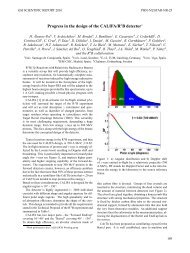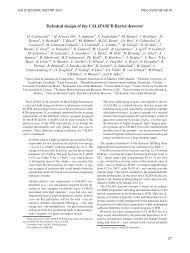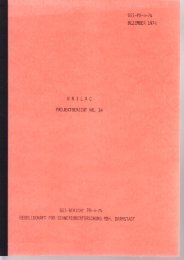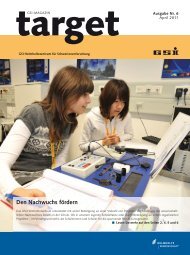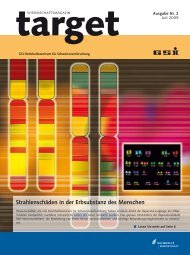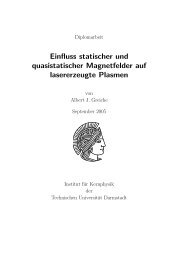Radiation Hardness Studies of Monolithic Active Pixel Sensors ...
Radiation Hardness Studies of Monolithic Active Pixel Sensors ...
Radiation Hardness Studies of Monolithic Active Pixel Sensors ...
Erfolgreiche ePaper selbst erstellen
Machen Sie aus Ihren PDF Publikationen ein blätterbares Flipbook mit unserer einzigartigen Google optimierten e-Paper Software.
ARTICLE IN PRESS<br />
on rates per atom<br />
s/atom s) Error (%)<br />
5.3<br />
5.6<br />
5.4<br />
5.5<br />
7.8<br />
10.3<br />
6.2<br />
6.6<br />
5.3<br />
5.2<br />
5.1<br />
6.5<br />
5.5<br />
6.9<br />
5.3<br />
5.8<br />
12.7<br />
16.9<br />
7.1<br />
7.2<br />
iate and thermal<br />
were considered.<br />
listed in standard<br />
36 KAPITEL 4. METHODEN ZUR STRAHLENHÄRTEUNTERSUCHUNG<br />
clear Instruments and Methods in Physics Research A 593 (2008) 466–471<br />
Fig. 5. Circles: neutron spectrum <strong>of</strong> MEDAPP with standard filter set (1 cm B4C epoxy and 3.5 cm lead), based on results <strong>of</strong> the modified MCNP simulations<br />
(Section 2.1) and adjusted via an equalisation calculation with the measured data<br />
from multiple foil activation (Section 3.1). Results <strong>of</strong> the transmission calculation<br />
(Section 2.2, solid line) and the analytical fit (Section 2.3, dashed line) are shown<br />
for comparison.<br />
Abbildung 4.2: Das Neutronenspektrum, entnommen aus [BWRP08]. Die Bestrahlung wird mit<br />
dem in [BWRP08] definierten Standardfilterset durchgeführt, um hauptsächlich mit schnellen<br />
Neutronen zu bestrahlen.<br />
detector count.<br />
tributed by the<br />
40 keV 103m and large uncertainties in cross-sections, errors become large<br />
above 5 MeV.<br />
As expected, the spectrum resulting from the transmission<br />
calculation was very similar to the one obtained from MCNP<br />
but exhibiting a more pronounced structure, although it lacked<br />
the small thermal peak. Cell-flagged MCNP calculations showed<br />
that thermal neutrons originate from moderation processes in<br />
the collimator and can therefore not be seen in transmission<br />
calculations.<br />
The mean energy was determined to be 1.9(1) MeV, slightly<br />
lower than a pure<br />
Rh<br />
235 U fission spectrum (2 MeV). The kerma<br />
weighted mean energy is 2.7(2) MeV, the median energy is<br />
1.5(1) MeV.<br />
Simulation and measurements are consistent within<br />
their error margins. The spectrum is shaped as expected<br />
from simple considerations regarding materials and geometry.<br />
This can also be seen in the analytical fit as described in<br />
Section 2.3. After filtering, the best analytical expression for the<br />
spectrum is<br />
fðEÞ ¼1:24 10 20 4.2.1 Neutronenbestrahlung<br />
per atom for thermal<br />
s/atom s) Error Strahlenschäden (%) aus nicht-ionisierender Bestrahlung wurden durch eine Bestrahlung am FRM (II)<br />
in München mit hauptsächlich schnellen Neutronen einer Energie von maximal 10 MeV erzeugt.<br />
12.5Abbildung<br />
4.2 zeigt das Spektrum. Neutronen niedrigerer Energien wurden durch Absorber<br />
5.7herausgefiltert.<br />
Der Neutronenfluss wurde auf Neutronen einer Energie von 1 MeV umgerechnet.<br />
6.8Nach<br />
[BWRP08] erreicht der Neutronenfluss am FRM (II) eine Rate von 3,2(2) · 10<br />
5.5<br />
6.1<br />
5.2<br />
5.2<br />
E=25<br />
Ee<br />
9<br />
10 8 neq<br />
s cm2 . Damit<br />
ergibt sich aus der Bestrahlungszeit nach Tabelle 4.1 die im folgenden Kapitel verwendeten<br />
Bestrahlungsdosen im Bereich von 0,3 bis 1,95 · 1013 neq<br />
cm2 . Die ionisierende Strahlendosis des<br />
dem Neutronenfluss unterliegenden Gammahintergrundes wurde in der Größenordnung von<br />
≈ 100 kRad/1013 neq<br />
cm2 angegeben und ionisierende Strahlenschäden daraus dadurch unterdrückt,<br />
dass die Sensoren nicht gebondet wurden. Die Genauigkeit der Dosimetrie wird mit 10 %<br />
angegeben.<br />
þ 5:88 10 6 e 4:5 10 3 = ffiffi E<br />
p<br />
E 0:88<br />
þ 1:34 10 8 e E sinh ffiffiffiffiffiffi<br />
2E<br />
p . (17)




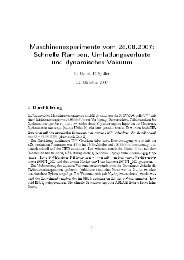
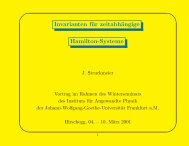
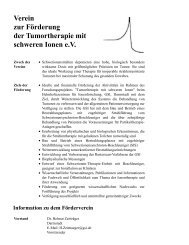
![GS I -P-]-17 - GSI Helmholtzzentrum für Schwerionenforschung](https://img.yumpu.com/20698964/1/184x260/gs-i-p-17-gsi-helmholtzzentrum-fur-schwerionenforschung.jpg?quality=85)

